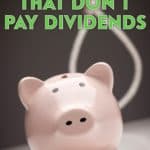Dividend Funds that Don’t Pay Dividends

One of the great ways to boost your investment portfolio is to add dividends. Dividend paying investments provide you with additional income from your investments, since they are payouts on top of capital appreciation. You can use the dividends as income, or you can even reinvest them to help you grow your portfolio at a faster rate.
Since dividend payouts are based on the number of shares you own, using your dividends to buy more shares can increase your payouts in the future. It’s a beneficial cycle that can boost the rate at which you grow your wealth.
It’s even relatively easy to start investing in dividends. There are many great dividend stocks in Canada. I personally have about 30 that I watch for adding to my Smith Manoeuvre. You can also invest in dividend paying funds to help your strategy. Unfortunately, if you’re looking to mutual funds to fill the Canadian dividend portion of your portfolio, you may not be getting what you pay for.
Mutual Funds and Dividend Payouts
One of the nice things about mutual funds is that you have the chance to spread the risk around. You get instant diversity, and a better bang for your buck if you don’t have a lot of capital to start with. There are dividend funds in Canada, but you have to be careful.
First off, since these dividend funds have Management Expense Ratios (MERs) in the 1.6-1.7% range, this creates quite a drag on the dividend income you can expect from this type of fund. If the dividends are low, the cost of the fund can completely negate the payout. To compensate for this, fund managers have to look elsewhere to bring the payout back up in “real” terms. This can mean looking for better performing funds… with higher expense ratios. It becomes a frustrating and counter-productive exercise if you aren’t careful.
Four of the five major Canadian Banks have Canadian Dividend funds that are made up of only about 85% Canadian equities. TD bank was the only exception, being in the 95% range. The rest of these funds include T-bills, as well as US and international equities. Even within the Canadian equities portion, not all stocks are dividend paying equities and other stocks have low or unstable dividend payments.
The reality of fund composition creates a few issues. You are not getting only the dividend paying equities that you were looking to add to your portfolio; you are likely just adding another high-MER equity fund with a different name. This fund will also not provide the tax efficiency of a true dividend only fund, since the payouts include capital gains and return of capital (ROC). You need to dig down into the realities of the fund’s makeup in order to determine whether or not you are truly getting what you think you are.
Choose Better Funds for Your Dividend Portfolio
So what are your options for adding dividend paying companies to your portfolio? With mutual funds, not much, though the TD Dividend Growth funds may be closer to the real thing. The truth is that there just isn’t much to choose from when it comes to true dividend paying mutual funds in Canada. You don’t want to pay high expenses; you want to get a low-cost fund with the true tax benefits of investing in Canada dividend assets.
Your best option might be index funds Exchange Traded Funds (ETFs). ETFs are similar to mutual funds, but they often come with much lower costs, and they are traded like stocks on the exchanges. You can get the benefits of mutual funds, but without some of the costs. Plus, many dividend ETFs don’t include all those other income investments that can dilute your dividend payments.
If you’re looking for a dividend ETF, the iShares CDN Dividend Index Fund (XDV) is a solid choice. While you may have to pay commissions to buy these ETFs, the 0.5-0.6% MER and the fact that you get the dividend paying stocks that you’re looking for will make it worthwhile.


Comments
I totally hear you with the MER
I had the Scotiabank Dividend Growth fund, and it had a 1.6% MER. My annual dividend was effectively less than what was taken from the MER.
USELESS!
Rick, if you’re just starting out and you want a balanced RRSP portfolio, look at the TD eSeries funds. You could transfer your RBC mutual fund to there through the application form.
TD e-Series Funds
While the dividend ETFs could replace the RBC dividend fund just fine, I wouldn’t recommend only that in your RRSP.
I am just starting to save money through an RRSP at Royal Bank. I dont have much saved yet, but I’m thinking of transfering it to one of the Dividend ETFs you mentioned. Would it be stupid to put all of my RRSP amount into one ETF? If so, how much of your portfolio should you put towards dividends?
VP, I’d have to suggest the e-Series funds again. In this article I looked at the dividend ETFs to be a closer comparison to the dividend mutual funds, but ultimately these “dividend” funds are just another equity fund.
But when is comes to what you might want when starting out with investing. The four e-Series funds I mentioned in the links above are hard to beat. I was in the exact same situation starting out as you and Rick, I switched to the e-Series funds in my second year and haven’t looked back!
You have the right idea that making the switch would instantly improve your chance of good results by 1.61%… but equally important is that the Canadian Index e-Series covers the entire TSX and gives you better diversification than what you currently have.
I am also switching to TD e-Series funds, from Dividend Growth, Dividend Income, Monthly Income, and Canadian Index.
MER is one factor, the other factor is performance.
I own TD Dividend Growth funds that I contribute to on a monthly basis. I don’t have enough money in it (under $3k) to switch to an ETF, but the TD Canadian Index e-Series has a very attractive MER of .31% (vs 1.92% for Dividend Growth). My plan is to accumulate mutual funds first then switch to ETFs eventually.
Given my position am I better off switching to TD Canadian Index e-Series? I’m only in my 2nd year of investing.
Thanks for the advice. I too have less than 3k, so I guess it was a bit premature for me to be looking at ETFs. I’ll definitely look into the e-Series funds.
Fantastic blog, by the way!
When an equity fund reinvests the dividend back into the fund, should the fund investor see his number of units grow or does the number of units in the portfolio remain unchanged?
Hi,
I have about $10K sitting in a money market fund at RBC and i am trying to find a good way to invest in my RRSP – I love dividends and already DRIP through a transfer agent but don’t want the hassle of doing that every month through my RRSP – I want it to be very easy! I am in my early 40’s and lost alot in 2008 and now my bond has matured and I want to put it into something that will grow. I have looked at various options but am very confused – any advise? I have looked at
Claymore S&P/TSX Canadian Dividend ETF (CDZ)
TD efunds
iShares CDN Dividend Index Fund
Thank you!
Amina
if you can not decide you can check the MERs, how long the etf is in business, and annual return. If you are still undecided devide your fund into 3 and invest in all 3. I believe ETFs charge the lowest MER comparing to TD e-series.
Sometimes I am not even sure that those funds are ran for shareholders benefit: http://www.niterainbow.com/2014/04/activist-investors-or-whether-companies.html
I would agree with the author and am invested mainly in Canadian bank shares, Index ETFs, some sector ETFs, TD e-series, and some other mutual funds. I would recommend for people to save/invest in their RSPs and TFSAs and contribute as much as you can, and accumulate wealth. You need to start, contribute regularly and once you saved enough open a brokarage account and start buying stocks,and ETFs. The sooner you start saving the sooner you will have more but set a small goal first and once you reach it set a bit bigger goals, and so on.
imaxx CDN Fix
Franklin Bissett CDN high div
both are the gems to give you what you seek
I want my son to be active young and smart financially , like I was not. Can I set up an investment for him with a small sum of money, that would provide both a portion of cash dividends to him, at the same time reinvesting the other portion (and my small mthly contrib) inside the same fund. I think it would be a great learning tool very easy to understand, pays AND grows. then at the age of 18,21 or so hand it over to him. What about a % of his net going into this fund ?…maxed out on RESP grant room…single parent situation…idea fits my goals, its not much money, he would learn…this taxable income from divident not really an issue, kids to lazy to work…LOL..